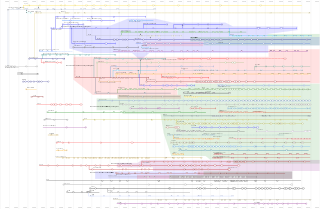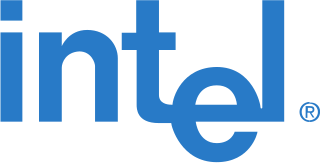
United States of America v. Microsoft Corporation, 253 F.3d 34, was a landmark American antitrust law case at the United States Court of Appeals for the District of Columbia Circuit. The U.S. government accused Microsoft of illegally monopolizing the web browser market for Windows, primarily through the legal and technical restrictions it put on the abilities of PC manufacturers (OEMs) and users to uninstall Internet Explorer and use other programs such as Netscape and Java.

Netscape Navigator is a discontinued proprietary web browser, and the original browser of the Netscape line, from versions 1 to 4.08, and 9.x. It was the flagship product of the Netscape Communications Corp and was the dominant web browser in terms of usage share in the 1990s, but by around 2003 its user base had all but disappeared. This was partly because the Netscape Corporation did not sustain Netscape Navigator's technical innovation in the late 1990s.
Netscape Communications Corporation was an American independent computer services company with headquarters in Mountain View, California, and then Dulles, Virginia. Its Netscape web browser was once dominant but lost to Internet Explorer and other competitors in the so-called first browser war, with its market share falling from more than 90 percent in the mid-1990s to less than one percent in 2006. An early Netscape employee, Brendan Eich, created the JavaScript programming language, the most widely used language for client-side scripting of web pages. A founding engineer of Netscape, Lou Montulli, created HTTP cookies. The company also developed SSL which was used for securing online communications before its successor TLS took over.

ActiveX is a deprecated software framework created by Microsoft that adapts its earlier Component Object Model (COM) and Object Linking and Embedding (OLE) technologies for content downloaded from a network, particularly from the World Wide Web. Microsoft introduced ActiveX in 1996. In principle, ActiveX is not dependent on Microsoft Windows operating systems, but in practice, most ActiveX controls only run on Windows. Most also require the client to be running on an x86-based computer because ActiveX controls contain compiled code.
Originally, the word computing was synonymous with counting and calculating, and the science and technology of mathematical calculations. Today, "computing" means using computers and other computing machines. It includes their operation and usage, the electrical processes carried out within the computing hardware itself, and the theoretical concepts governing them.

A browser war is a competition for dominance in the usage share of web browsers. The "first browser war" (1995–2001) consisted of Internet Explorer and Netscape Navigator, and the "second browser war" (2004-2017) between Internet Explorer, Firefox, and Google Chrome.

Intel Architecture Labs (IAL) was the personal-computer system research-and-development arm of Intel during the 1990s.
San Francisco Canyon Company was a software development company that was contracted by Apple Computer in 1992 to port the QuickTime technology to Microsoft Windows. They made their first release of QuickTime for Windows in November 1992.
Video for Windows was a suite of video-playing and editing software introduced by Microsoft in 1992. A runtime version for viewing videos only was made available as a free add-on to Windows 3.1, which then became an integral component of Windows 95. Video for Windows was mostly replaced by the July 1996 release of ActiveMovie, later known as DirectShow. Apple filed a lawsuit in 1994 alleging theft of several thousand lines of QuickTime source code to improve the software. The case was settled in 1997, when Apple agreed to make Internet Explorer the default browser over Netscape, and in exchange, Microsoft agreed to continue developing Microsoft Office and other software for Mac OS for the next 5 years, and purchase $150 million of non-voting Apple stock.

Microsoft Internet Explorer 3 (IE3) is the third, and by now, discontinued, version of the Internet Explorer graphical web browser which was announced in March 1996, and was released on August 13, 1996 by Microsoft for Microsoft Windows and on January 8, 1997 for Apple Mac OS. It began serious competition against Netscape Navigator in the first Browser war. It was Microsoft's first browser release with a major internal development component. It was the first more widely used version of Internet Explorer, although it did not surpass Netscape or become the browser with the most market share. During its tenure, IE market share went from roughly 3–9% in early 1996 to 20–30% by the end of 1997. In September 1997 it was superseded by Microsoft Internet Explorer 4.

Microsoft Internet Explorer 2 (IE2) is the second, and by now discontinued, version of Internet Explorer (IE), a graphical web browser by Microsoft. It was unveiled in October 1995, and was released on November 27, 1995, for Microsoft Windows, and on April 23, 1996, for Apple Macintosh.
Maher Mofeid "Mike" Hawash is an American engineer who was convicted and sentenced to a seven-year prison sentence in 2003 for conspiring to aid the Taliban in fighting against U.S. forces and their allies in Afghanistan. Six weeks after 9/11, Hawash secretly traveled to China with a group of Portland-area Muslims, dubbed the Portland Seven, with the intent of entering Afghanistan to aid the Taliban. Hawash and his fellow conspirators were unable to reach Afghanistan due to visa problems, according to federal authorities,
Host signal processing (HSP) is a term used in computing to describe hardware such as a modem or printer which is emulated (to various degrees) in software. Intel refers to the technology as native signal processing (NSP). HSP replaces dedicated DSP or ASIC hardware by using the general purpose CPU of the host computer.

The World Wide Web is a global information medium that users can access via computers connected to the Internet. The term is often mistakenly used as a synonym for the Internet, but the Web is a service that operates over the Internet, just as email and Usenet do. The history of the Internet and the history of hypertext date back significantly further than that of the World Wide Web.
The Microsoft Java Virtual Machine (MSJVM) is a discontinued proprietary Java virtual machine from Microsoft. It was first made available for Internet Explorer 3 so that users could run Java applets when browsing on the World Wide Web. It was the fastest Windows-based implementation of a Java virtual machine for the first two years after its release. Sun Microsystems, the creator of Java, sued Microsoft in October 1997 for incompletely implementing the Java 1.1 standard. It was also named in the United States v. Microsoft Corp. antitrust civil actions, as an implementation of Microsoft's "Embrace, extend and extinguish" strategy. In 2001, Microsoft settled the lawsuit with Sun and discontinued its Java implementation.
A web browser is a software application for retrieving, presenting and traversing information resources on the World Wide Web. It further provides for the capture or input of information which may be returned to the presenting system, then stored or processed as necessary. The method of accessing a particular page or content is achieved by entering its address, known as a Uniform Resource Identifier or URI. This may be a web page, image, video, or other piece of content. Hyperlinks present in resources enable users easily to navigate their browsers to related resources. A web browser can also be defined as an application software or program designed to enable users to access, retrieve and view documents and other resources on the Internet.
"Embrace, extend, and extinguish" (EEE), also known as "embrace, extend, and exterminate", is a phrase that the U.S. Department of Justice found was used internally by Microsoft to describe its strategy for entering product categories involving widely used open standards, extending those standards with proprietary capabilities, and using the differences to strongly disadvantage its competitors.
Glenford Myers is an American computer scientist, entrepreneur, and author. He founded two successful high-tech companies, authored eight textbooks in the computer sciences, and made important contributions in microprocessor architecture. He holds a number of patents, including the original patent on "register scoreboarding" in microprocessor chips. He has a BS in electrical engineering from Clarkson University, an MS in computer science from Syracuse University, and a PhD in computer science from the Polytechnic Institute of New York University.
An Internet operating system, or Internet OS, is any type of operating system designed to run all of its applications and services through an Internet client, generally a web browser. The advantages of such an OS would be that it would run on a thin client, allowing cheaper, more easily manageable computer systems; it would require all applications to be designed on cross-platform, open standards; and would not tie a user's applications, documents, and preferences to a single computer, but rather place them in the Internet cloud. The Internet OS has also been promoted as the perfect type of platform for software as a service.

Thomas Reardon is an American computational neuroscientist and the CEO and co-founder of CTRL-labs. Formerly, he was a computer programmer and developer at Microsoft. He is credited with creating the project to build Microsoft's web browser, Internet Explorer (IE), which was the world's most used browser during its peak in the early 2000s. He founded CTRL-labs in 2015 with neuroscientists from Columbia University. Following the acquisition of CTRL-labs he leads the neural interfaces group at Facebook Reality Labs.







